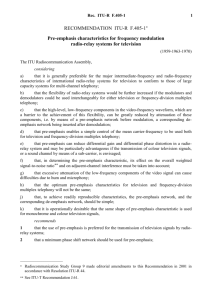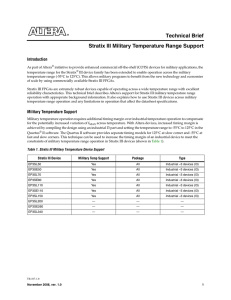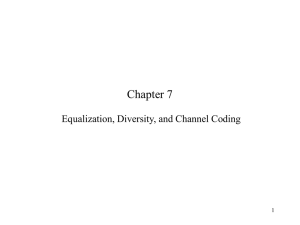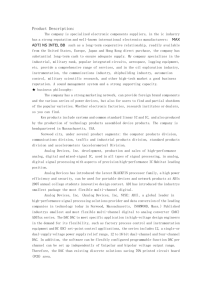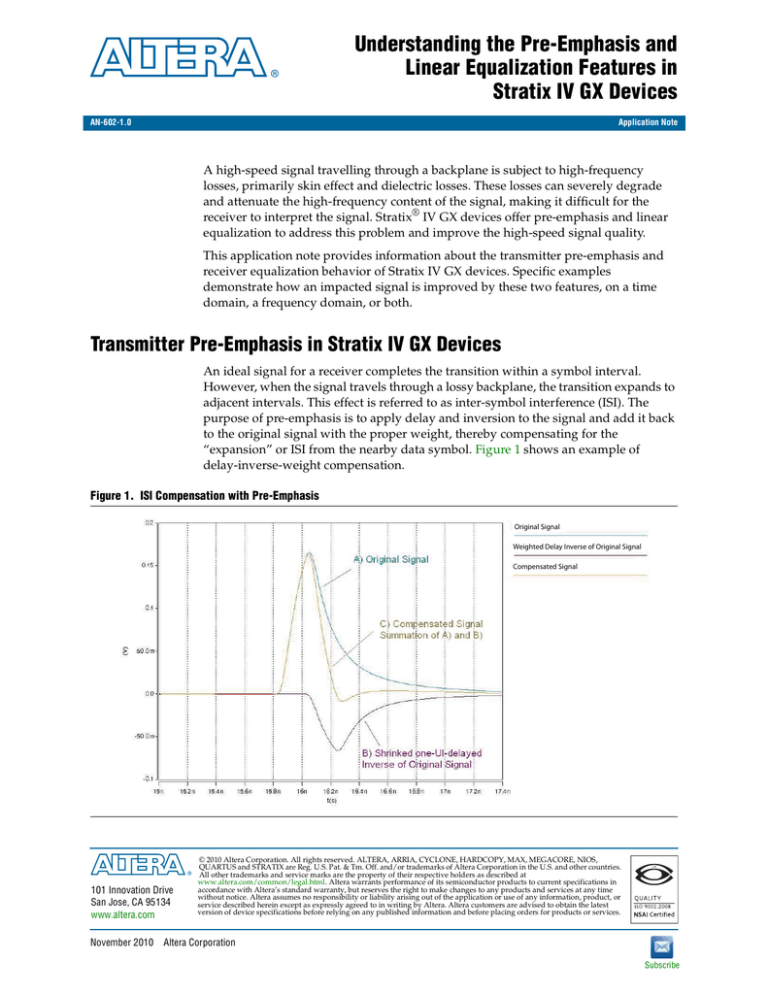
Understanding the Pre-Emphasis and
Linear Equalization Features in
Stratix IV GX Devices
AN-602-1.0
Application Note
A high-speed signal travelling through a backplane is subject to high-frequency
losses, primarily skin effect and dielectric losses. These losses can severely degrade
and attenuate the high-frequency content of the signal, making it difficult for the
receiver to interpret the signal. Stratix® IV GX devices offer pre-emphasis and linear
equalization to address this problem and improve the high-speed signal quality.
This application note provides information about the transmitter pre-emphasis and
receiver equalization behavior of Stratix IV GX devices. Specific examples
demonstrate how an impacted signal is improved by these two features, on a time
domain, a frequency domain, or both.
Transmitter Pre-Emphasis in Stratix IV GX Devices
An ideal signal for a receiver completes the transition within a symbol interval.
However, when the signal travels through a lossy backplane, the transition expands to
adjacent intervals. This effect is referred to as inter-symbol interference (ISI). The
purpose of pre-emphasis is to apply delay and inversion to the signal and add it back
to the original signal with the proper weight, thereby compensating for the
“expansion” or ISI from the nearby data symbol. Figure 1 shows an example of
delay-inverse-weight compensation.
Figure 1. ISI Compensation with Pre-Emphasis
Original Signal
Weighted Delay Inverse of Original Signal
Compensated Signal
101 Innovation Drive
San Jose, CA 95134
www.altera.com
November 2010
© 2010 Altera Corporation. All rights reserved. ALTERA, ARRIA, CYCLONE, HARDCOPY, MAX, MEGACORE, NIOS,
QUARTUS and STRATIX are Reg. U.S. Pat. & Tm. Off. and/or trademarks of Altera Corporation in the U.S. and other countries.
All other trademarks and service marks are the property of their respective holders as described at
www.altera.com/common/legal.html. Altera warrants performance of its semiconductor products to current specifications in
accordance with Altera’s standard warranty, but reserves the right to make changes to any products and services at any time
without notice. Altera assumes no responsibility or liability arising out of the application or use of any information, product, or
service described herein except as expressly agreed to in writing by Altera. Altera customers are advised to obtain the latest
version of device specifications before relying on any published information and before placing orders for products or services.
Altera Corporation
Subscribe
Page 2
Transmitter Pre-Emphasis in Stratix IV GX Devices
Depending on the channel characteristics, one simple delay, inversion, and weight
process may not be enough to achieve your target compensation. For example, the
compensation shown in Figure 1 only reduces the expansion after the main cursor
(the main pulse) but not the expansions before the cursor. Shrinking and inverting a
signal ahead of the current cursor can address the pre-cursor ISI.
To achieve the optimal channel loss compensation, you can combine different delays,
weights, and polarity in one pre-emphasis setup. Therefore, a real pre-emphasis
implementation generally works like a finite impulse response (FIR) filter with
different “taps,” which refer to signals after different unit delays.
In the frequency domain, pre-emphasis boosts the high-frequency energy on every
transition in the data stream.
Pre-Emphasis Features in Stratix IV GX Devices
A Stratix IV GX transmitter contains four programmable drivers. One is the main
driver, V OD, which controls the base amplitude with or without pre-emphasis. The
other three are pre-emphasis taps: pre-tap, 1st post-tap, and 2nd post-tap. A polarity
setting is also available for the pre-tap and 2nd post-tap. Multiple programmable
pre-emphasis taps and polarity flexibility can address a large number of backplanes
with different channel characteristics. Figure 2 shows a Stratix IV GX pre-emphasis
digital filter with VOD and three pre-emphasis taps.
Figure 2. Pre-Emphasis Digital Filter
Pre-tap
Z +1
+/-
VOD
1st Post-tap
Z –1
2nd Post-tap
Z –2
+/-
Pre-emphasis Digital Filter
Understanding the Pre-Emphasis and Linear Equalization Features in Stratix IV GX Devices
November 2010
Altera Corporation
Transmitter Pre-Emphasis in Stratix IV GX Devices
Page 3
Figure 3 shows how a differential pre-emphasis signal is generated with the 1st
post-tap. The original positive-leg signal Vp(T) is compared with the unit-delayed
positive-leg signal Vp(T-1). Assuming the pre-emphasis weight is x (0<x<1), the
difference between the Vp(T) signal and the weighted x*Vp(T-1) signal is the
emphasized signal (positive-leg). The negative-leg of the emphasized signal is
similarly generated. The pre-emphasized differential signal is differentiated from the
positive-leg and negative-leg signals.
Figure 3. Pre-Emphasis Signal Generation
0
1
1
1
0
0
0
Vp(T)
Original Signal
Positive-Leg
0
0
1
1
1
0
0
Vp(T–1)
Unit-Delayed Signal
Positive-Leg
0
0
x
x
x
0
0
x*Vp(T–1)
Weighted Tap Signal
Positive-Leg
0
1
1 -x
1 -x
-x
0
0
1
0
0
0
1
1
1
Vn(T)
Original Signal
Negative-Leg
1 -x
-x
0
0
1
1 -x
1 -x
Vn(T) – x*Vn(T–1)
Pre-emphasized Signal
Negative-Leg
x-1
1+x
1 -x
1 -x
-1 -x
x-1
x-1
Vp(T) – x*Vp(T–1) – Vn(T) + x*Vn(T–1)
Vp(T) – x*Vp(T–1) Pre-emphasized Signal
Positive-Leg
Pre-emphasized Signal
Differential
November 2010
Altera Corporation
Understanding the Pre-Emphasis and Linear Equalization Features in Stratix IV GX Devices
Page 4
Transmitter Pre-Emphasis in Stratix IV GX Devices
Effects of Each Pre-Emphasis Tap
The following analysis demonstrates the effects of each tap with ideal and simulation
waveforms. A pattern with long 1s and long 0s is used for this purpose. Figure 4
shows a sample data pattern with long 1s and 0s. A 1010 high-frequency pattern is not
suitable in this study because the pre-emphasis effect on the consecutive bits is not
visible with such a pattern. A pseudo-random binary sequence (PRBS) is not suitable
because the random transitions combine and complicate the effects of different taps.
Figure 4. Sample Data Pattern with Long 1s and 0s
The simulation is running at 5 Gbps on a Stratix IV GX HSSI Verilog-A buffer model
without package, with VOD=8 mA and a 100-Ω internal termination. The following
simulation waveforms are probed at the differential buffer output. The green
waveforms represent a signal without pre-emphasis. The purple waveforms are
signals with pre-emphasis. The brown waveforms for 2nd post-tap and pre-tap are
also signals with pre-emphasis but with different polarity.
Understanding the Pre-Emphasis and Linear Equalization Features in Stratix IV GX Devices
November 2010
Altera Corporation
Transmitter Pre-Emphasis in Stratix IV GX Devices
Page 5
The 1st post-tap is usually the most effective tap. It emphasizes the bit period
immediately after the transition and de-emphasizes the remaining bits (Figure 5).
Because of the nonlinear saturation effect when combining the 1st post-tap and VOD,
the emphasizing above VOD is not as significant as de-emphasizing below VOD.
Figure 5. Effect of the 1st Post-Tap
a) Ideal 1st post-tap effect (assuming VOD=1 and x is the tap weight)
(V) : t(s)
1tap ON
1tap OFF
b) Stratix IV GX 1st post-tap simulation
November 2010
Altera Corporation
Understanding the Pre-Emphasis and Linear Equalization Features in Stratix IV GX Devices
Page 6
Transmitter Pre-Emphasis in Stratix IV GX Devices
The 2nd post-tap de-emphasizes the first two bits after the transition and emphasizes
the remaining bits. A different polarity on the 2nd post-tap does the opposite
(Figure 6).
Figure 6. Effect of the 2nd Post-Tap
a) Ideal 2nd post-tap effect (assuming VOD=1 and x is the tap weight)
(V) : t(s)
No Pre-tap
2nd tap = 7
2nd tap = -7
b) Stratix IV GX 2nd post-tap simulation
Understanding the Pre-Emphasis and Linear Equalization Features in Stratix IV GX Devices
November 2010
Altera Corporation
Transmitter Pre-Emphasis in Stratix IV GX Devices
Page 7
The pre-tap de-emphasizes the bit before the transition and emphasizes the remaining
bits. A different polarity on pre-tap does the opposite (Figure 7). In a system that
features DFE in the receiver, pre-tap is important. Because DFE can only address the
post-cursor ISI, pre-tap in a Stratix IV GX device can reduce the pre-cursor ISI effect.
Figure 7. Effect of the Pre-Tap
a) Ideal pre-tap effect (assuming VOD=1 and x is the tap weight)
(V) : t(s)
Pre-tap = -7
No Pre-tap
Pre-tap = 7
b) Stratix IV GX pre-tap simulation
November 2010
Altera Corporation
Understanding the Pre-Emphasis and Linear Equalization Features in Stratix IV GX Devices
Page 8
Transmitter Pre-Emphasis in Stratix IV GX Devices
Figure 8 shows the eye diagram of a PRBS-7 pattern after a lossy channel without
pre-emphasis (shown on the left) and with certain pre-emphasis taps on (shown on
the right). The significant difference between the two eyes demonstrates how
pre-emphasis can improve signal integrity through the lossy channel.
Figure 8. Eye Diagram of Data Pattern without Taps and with Taps (Note 1)
Note to Figure 8:
(1) Comparing the marker readings of the two cases, the eye width increased from 61.7 ps to approximately 98.72 ps, a gain of 37 ps or 60%.
Similarly, the eye height increased from 108.9 mV to approximately 178.9 mV, a gain of 70 mV or 64.3%.
Amount of Pre-Emphasis Change
Pre-emphasis is often quantified with the percentage obtained through the
pre-emphasis taps. You can calculate the percentage from the amplitudes of the
emphasized signal (V1) and the de-emphasized signal (V2), as shown in Equation 1.
Equation 1.
% Voltage change = [ ( V 1 – V 2 ) ⁄ V 2 ] × 100
dB increase = 20 log ( V 1 ⁄ V 2 )
Assume VOD is set to V and the pre-emphasis tap weight is x. The emphasized signal
amplitude is V1=V+x and the de-emphasized signal amplitude is V2=V-x. Replacing
V1 and V2 in Equation 1 leads to Equation 2.
Equation 2.
% Voltage change = [ 2x ⁄ ( V – x ) ] × 100
dB increase = 20 log [ ( V + x ) ⁄ ( V – x ) ]
Equation 2 shows how the pre-emphasis tap setting and VOD setting impact the
percentage achieved by the pre-emphasis tap:
■
The bigger the pre-emphasis tap, the more the percentage changes
■
The bigger the VOD, the less the percentage changes
Understanding the Pre-Emphasis and Linear Equalization Features in Stratix IV GX Devices
November 2010
Altera Corporation
Transmitter Pre-Emphasis in Stratix IV GX Devices
Page 9
Figure 9 shows an example of the percentage changes achieved with different VOD
and 1st post-tap settings. The top waveform has VOD = 6 mA and tap1 = 21. The
percentage is quantified at 165%. The middle waveform increases VOD to 8 mA and
uses the same tap1 setting. The percentage is reduced to 80.3%. The bottom waveform
uses the same VOD as the middle waveform but reduces the tap1 setting to 14. The
percentage is reduced to 45.7%.
Figure 9. Percentage Change Variation with VOD and Pre-Emphasis Tap Setting
(V) : t(s)
VOD = 6 mA, tap1 = 21
(V) : t(s)
VOD = 8 mA, tap1 = 21
(V) : t(s)
VOD = 8 mA, tap1 = 14
Altera’s transmitter implements both pre-emphasis and de-emphasis. It increases the
high-frequency components and decreases the low-frequency components. The total
amount of emphasis is the difference between pre-emphasis and de-emphasis. The
advantage of this implementation is that it dissipates less power than the traditional
pre-emphasis and achieves the same amount of emphasis.
Limitations of Pre-Emphasis
Pre-emphasis increases the signal edge rate, which increases the crosstalk on the
neighboring channels. Meanwhile, because pre-emphasis emphasizes the transition
bits and de-emphasizes the remaining bits, if there is any discontinuity along the
channel, the reflection at the discontinuity is more complicated than without
pre-emphasis. Because the impact of pre-emphasis on crosstalk and channel
discontinuity is highly case-dependent, simulation is required to ensure the impact is
minimal.
The pre-emphasis selection is also a key to the signal integrity at the receiver.
Over-emphasis tends to degrade rather than help the receiver signal quality.
Stratix IV GX devices offer multiple toolkits to determine or simulate the best
pre-emphasis setting for a given backplane.
November 2010
Altera Corporation
Understanding the Pre-Emphasis and Linear Equalization Features in Stratix IV GX Devices
Page 10
Linear Equalization in Stratix IV GX Receivers
Linear Equalization in Stratix IV GX Receivers
Receiver equalization is another signal conditioning feature to overcome
high-frequency losses through a transmission channel. An equalizer acts as a band
pass filter, which boosts the contents inside a band of frequencies and attenuates both
the high and low frequency contents outside. Figure 10 shows an example of
equalization compensating channel loss. The channel loss at 3.25 GHz is
approximately –16.5 dB. The equalization boosts the gain by 14.9 dB at 3.25 GHz, thus
bringing the end gain up to –1.6 dB.
Figure 10. Equalization Compensating Channel Loss
(dBV) : f(Hz)
Channel Loss
Gain after Channel and Equalization
Equalization Gain
Programmable Linear Equalization in Stratix IV GX Devices
The Stratix IV GX receiver supports programmable common mode voltage (RX Vcm),
equalization, DC gain, and on-chip termination (OCT) settings. A Stratix IV GX
receiver may also support an optional adaptive equalization, ADCE.
Understanding the Pre-Emphasis and Linear Equalization Features in Stratix IV GX Devices
November 2010
Altera Corporation
Linear Equalization in Stratix IV GX Receivers
Page 11
Figure 11 shows the Stratix IV GX receiver input buffer.
Figure 11. Receiver Input Buffer
The programmable linear equalization is optimized at 6.5 Gbps. There are 16
equalization modes that boost the high-frequency content from 2.6 dB (Mode 0) to
17.8 dB (Mode 15). Figure 12 shows the equalizer gain curves of the different
equalization modes offered in the Stratix IV GX receiver.
Figure 12. Linear Equalizer Gain Curves
November 2010
Altera Corporation
Understanding the Pre-Emphasis and Linear Equalization Features in Stratix IV GX Devices
Page 12
Linear Equalization in Stratix IV GX Receivers
Signal Quality with Linear Equalization in a Stratix IV GX Receiver
Figure 13 shows an example of equalization compensation on a lossy channel. Four
equalization modes—Mode 0, Mode 5, Mode 10, and Mode 15—are applied to the
data stream out of the channel. All the eye diagrams are differential signals probed at
equalizer output.
■
Mode 0 provides very little high-frequency boost. The eye is completely closed
because of the channel loss.
■
Mode 5 achieves limited eye opening from a high-frequency boost.
■
Mode 10 provides much more high-frequency boost and the eye is wide open with
a 400 mV eye height.
■
Mode 15 has the most high-frequency boost but the eye is not as clean as Mode 10.
This behavior is called over-equalization.
Figure 13. Eye Diagrams of Equalization Outputs
Understanding the Pre-Emphasis and Linear Equalization Features in Stratix IV GX Devices
November 2010
Altera Corporation
Linear Equalization in Stratix IV GX Receivers
Page 13
Frequency Dependency of the Linear Equalizer
The linear equalizer is frequency dependent. The boost at the optimal frequency and
the boost at the other frequencies can vary significantly. You can see this behavior by
studying the equalization output with sinusoidal inputs at different data rates.
In Figure 14, a 6.5 Gbps sinusoidal input (magenta) is sent into the equalizer. The
equalizer outputs (green, brown, purple, and blue waveforms) are amplified by up to
550 mV. However, with a sinusoidal input at 650 Mbps (Figure 15), the equalization
will only amplify 87 mV, even at the highest equalization setting. The key is the peak
frequency of the equalizer gain. A 6.5 Gbps input data is running at the peak
frequency while a 650 Mbps input is running at only 10% of the peak frequency. As
seen in Figure 12, the closer the input data frequency is to the peak frequency, the
more equalization gain the equalizer provides.
Figure 14. Receiver Equalizer Response to 6.5 Gbps Sinusoidal Input
November 2010
Altera Corporation
Understanding the Pre-Emphasis and Linear Equalization Features in Stratix IV GX Devices
Page 14
Conclusion
Figure 15. Receiver Equalizer Response to 650 Mbps Sinusoidal Input
Limitations of Linear Equalization
Linear equalization boosts the high-frequency component of the input stream,
regardless of data signal or noise. If the noise introduced in the channel is in the
optimal frequency range of the equalization, the noise component is boosted and
negatively impacts the correct sampling of the data stream and clock data recovery
(CDR).
Similar to pre-emphasis, equalization selection is also a key to the signal integrity of
the equalizer output. Over-equalization degrades the signal quality instead of
improving it. Stratix IV GX devices offer multiple toolkits to determine and simulate
the best receiver equalization setting in a given backplane.
Conclusion
This application note describes how pre-emphasis and linear equalization
compensate for high-frequency losses. Pre-emphasis inverts, shifts, and shrinks the
adjacent symbols to boost the bit transition. Linear equalizer amplifies the gain in
certain frequency ranges.
Stratix IV GX devices offer programmable pre-emphasis and linear equalization.
Pre-emphasis in a Stratix IV GX transmitter has one pre-tap and two post-taps with
programmable weight and polarity. Linear equalization in a Stratix IV GX receiver is
optimized at 6.5 Gbps and has 16 different modes that provide a high-frequency boost
from 2.6 dB to 17.8 dB.
Understanding the Pre-Emphasis and Linear Equalization Features in Stratix IV GX Devices
November 2010
Altera Corporation
Document Revision History
Page 15
Pre-emphasis and linear equalization can work together to compensate for the
high-frequency channel loss. The setting selection is also critical for pre-emphasis and
linear equalization to achieve optimal compensation. Stratix IV GX devices offer
multiple toolkits to determine or simulate the optimal setting.
Document Revision History
Table 1 lists the revision history for this application note.
Table 1. Document Revision History
Date
Version
November 2010
November 2010
1.0
Altera Corporation
Changes
Initial release.
Understanding the Pre-Emphasis and Linear Equalization Features in Stratix IV GX Devices
Page 16
Understanding the Pre-Emphasis and Linear Equalization Features in Stratix IV GX Devices
Document Revision History
November 2010
Altera Corporation

